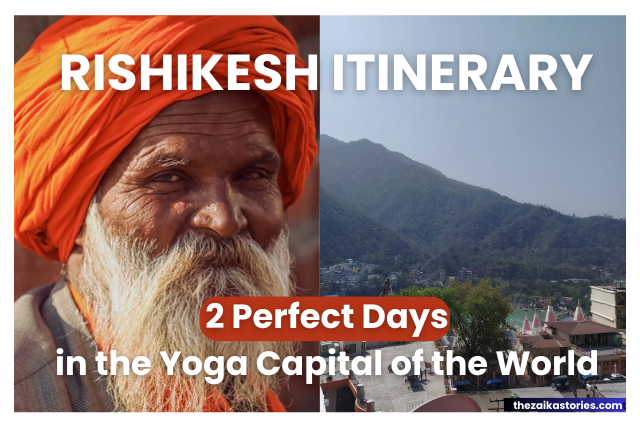Think about how often you find a place that blends spirituality, natural beauty, adventure, and mythology.
It’s pretty rare?
Well, that’s what comes to mind when I think of Rishikesh.
Rishikesh is special because it’s where the holy Ganges river flows right through the town, making the entire town look not just beautiful but also a place to visit for spiritual activities and rituals.
Much like Varanasi in Uttar Pradesh, Rishikesh is an important pilgrimage center for the Hindu religion.
You can do so much here, like taking a dip in the holy Ganges, visiting age-old temples, finding peace through Yoga and meditation, and experiencing adventure sports.
This town of Rishikesh has something for everyone who loves history, stunning views, and a bit of excitement.
I went to Rishikesh with my family, and it was the best weekend getaway ever.
So, if you’re also thinking about a trip to Rishikesh, I’ve curated a detailed itinerary and travel guide to ensure you make the most of your 2-day adventure in the Yoga Capital of the World.
What's in this Article
ToggleWhere is Rishikesh located in India map?
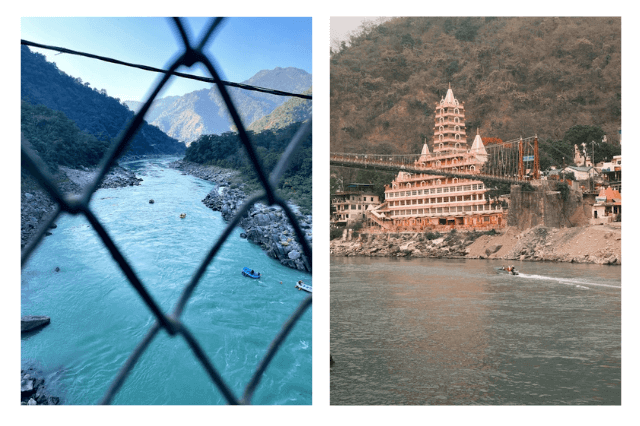
The name Rishikesh is derived from two Sanskrit words: Rishi, which means sage or saint, and Kesh, which means hair.
So, Rishikesh means the locks of the sage or the hair of the saint.
It is located in the northern part of India, in the state of Uttarakhand, near the border with the state of Himachal Pradesh, and it lies to the northeast of the national capital, New Delhi.
Why Is Rishikesh called the Yoga Capital of the World?

Rishikesh has been a favorite destination for those passionate about Yoga and meditation.
It’s known as the “Yoga Capital of the World” because of its rich history and a deep connection related to meditation.
As per Hindu Mythology, Lord Rama, his wife Sita, and brother Laxmana spent a long time in the forest region, now Rishikesh during their exile.
They dedicated a significant portion of their time there to intense meditation to make up for past actions related to the demon King Ravana.
During his meditation, Lord Rama pulled a strand of hair (Kesh) from his head.
This made the town famous as Rishikesh, which means the locks of the sage.
Also, many yoga communities, schools, retreats, and Ayurveda centers are here, making it very popular.
And it’s been like this for a long time.
But back in 1968, it got a boost when the Beatles,
Yes, those iconic musicians visited.
They were drawn by Maharishi Mahesh Yogi, a renowned guru who taught them a special meditation called Transcendental Meditation.
During their stay, the Beatles found inspiration in Rishikesh’s serene atmosphere and penned numerous songs, many of them featured on their renowned “White Album.
After their visit, Rishikesh became even more famous, especially among Westerners looking for spiritual experiences.
Soon, plenty of visitors arrived, eager to learn yoga and meditation, making Rishikesh the Yoga Capital of the World.
2 DAYS RISHIKESH ITINERARY: 15 Best things to do in Rishikesh
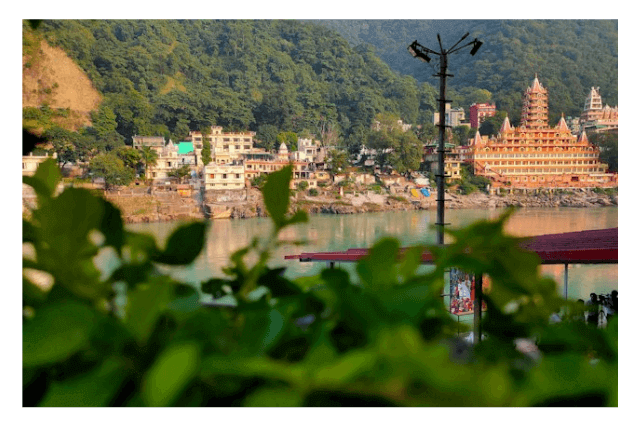
To have an amazing time in Rishikesh, it’s essential to plan.
By organizing your 2 days Rishikesh itinerary, you can ensure that you don’t miss any of the top places to visit or exciting things to do during your two-day stay.
I recommend staying for at least 2-3 days to make the most of your visit.
So, let’s begin by exploring the city’s areas, known for their rich history and culture.
Rishikesh Itinerary Day 1: Discover the Ganga River, Historical Temples, and Traditional Markets
On Day 1, we will immerse ourselves in the holiness of the sacred river Ganga, visit ancient temples with unique facts, and discover traditional markets in Rishikesh.
So, it will give you an idea of what Rishikesh is all about.
To make things easy for you, I have divided the exploration into two main areas: Places to visit near Laxman Jhula and Places to visit near Ram Jhula. This way, we can easily navigate each part of the city and make the most of our time.
1. Start your day with a refreshing dip in the sacred waters of the Ganga River Rishikesh
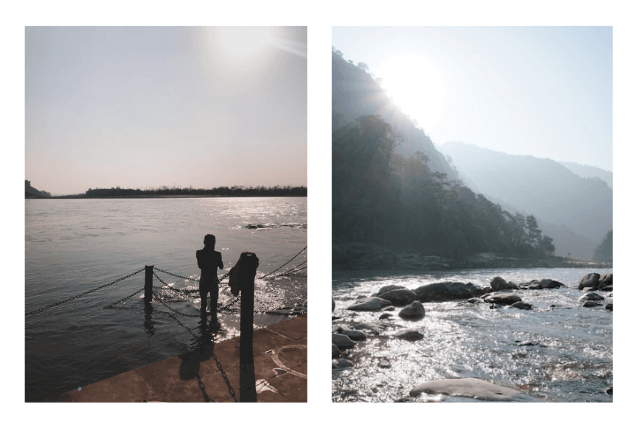
When I arrived at my hotel, which was right across from one of the ghats on the Ganga River, I started my day in Rishikesh by taking a dip in the holy river.
It felt really special and spiritual, as this was my first dip in the Ganga.
Bathing in the Ganga is thought to clean your soul and bring blessings.
Tip: Consider booking your accommodation at hotels near Laxman Jhula to simplify your sightseeing experience. This way, you’ll be closer to the main attractions and can easily explore the area without hassle.
You will see many sadhus and other visitors bathing in the Ganga in the morning and throughout the day.
As a woman, if you do not feel comfortable taking a dip around many people, washing your hands and feet in the water is enough. You can even take some of the holy water home if you want.
Fact- It is believed that if you sprinkle Ganga jal (water) around your home, it will wash away sins and purify the surroundings.
To take the water home, you can easily buy plastic containers for INR10 from the shops near the ghats, but ensure they’re leakproof.
2. Enjoy breakfast with a stunning view at the Sanskriti Organic Cafe
After the dip in the Ganga, head to the Sanskriti Organic Cafe to energize yourself for the day ahead.
It’s going to be a day full of exploration, so you’ll need some good fuel.
This is the best cafe in Rishikesh near Laxman Jhula,, providing stunning views of the hills and the Ganges from their balcony.
Along with the great view, the cafe offers a delicious selection of organic and healthy breakfast options.
Whether you’re craving classic pancakes with fresh fruit or traditional Indian dishes like masala dosa or aloo paratha, you’re in for a treat.
They even serve the most amazing Masala Tea (which I am obsessed with).
As it was morning time, the cafe was almost empty.
I could sit here all day, enjoying the peaceful vibes with a great view of the surroundings.
You can even grab a book from their collection and enjoy some peaceful reading. (if you’re an avid reader like me)
3. Visit the 100 years old iconic bridge of Laxman Jhula
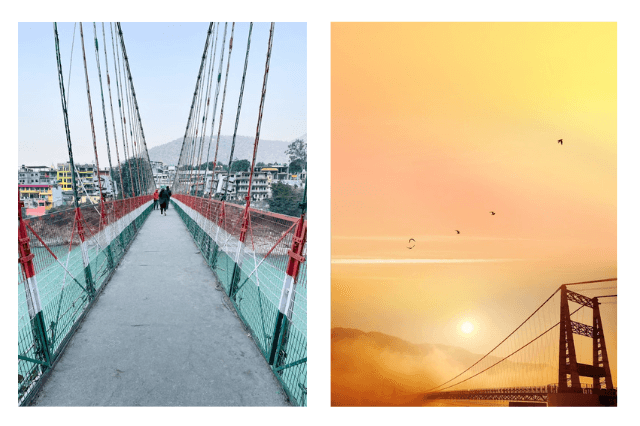
This bridge is over 100 years old and is a significant landmark in Rishikesh.
In 1923, recognizing the necessity of the bridge, the British government laid its foundation.
However, due to the swift currents of the River Ganga, the foundation was washed away twice.
Eventually, in 1930, the bridge was successfully constructed.
It’s now a symbol of the city’s culture and history.
Despite the narrowness of the bridge, it’s always bustling with traffic including bikes, cows, selfie-takes, and even monkeys.
Be prepared to find your way among them.
And remember, If the bridge shakes a bit, don’t worry, especially if it’s windy outside
Fact: Originally known as Jhula Pul (Swing bridge) due to its swaying motion in the wind, it was later renamed after Lord Laxmana, the younger brother of Lord Ram, who crossed it using a jute rope bridge in Hindu mythology.
This 450 feet long Laxman Jhula sits 70 feet above the river Ganga and connects two villages, Tapovan and Jonk
It’s even been featured in Bollywood movies.
You can visit anytime, day or night, but it’s best to go early in the morning around 5:00 am, or late at 10:00 pm to avoid crowds and enjoy the scenery.
It’s free to walk across the bridge, but if you want to take a bike or car, you might have to pay a small fee of INR 10 to 20.
You can also park your vehicle nearby and walk across if you prefer.
4. Visit the Laxman Temple, a significant religious site dedicated to Lord Laxman
Located near Laxman Jhula, a special Hindu temple devoted to Lord Laxman, Lord Rama’s brother.
When I visited the temple, it was calm and quiet despite the presence of many devotees.
I spent around 30 minutes in the temple, looking at the beautifully detailed designs it has.
You can simply sit in a corner for some time, say your prayers, and feel the spiritual atmosphere.
After the Laxman temple, I head over to see the most famous Tera Manzil Temple.
5. Discover the unique architecture of the Trimbakeshwar Temple in Rishikesh
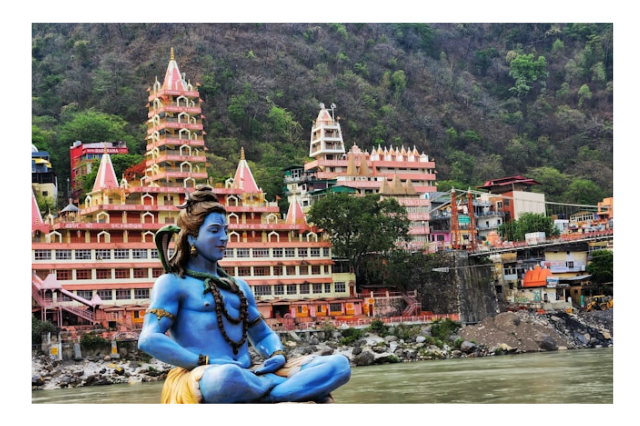
Located in the Tapovan area of Rishikesh, this temple is famous for its thirteen floors (Tera Manzil) and stunning views.
Tera Manzil Temple is dedicated to Lord Shiva, also known as the three-eyed Lord in Hindu mythology.
From the temple, you can also catch a glimpse of Laxman Jhula nearby.
The staircase of Tera Manzil temple ascends thirteen floors towards Lord Shiva.
Locals believe that Adi Shankaracharya built this temple between the 8th and 9th centuries.
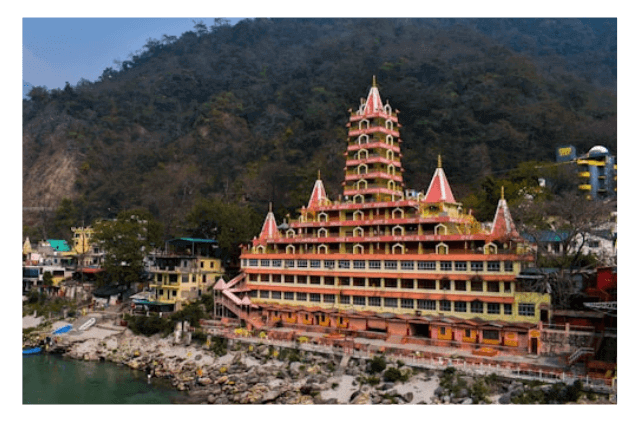
To my utter delight, I was all amazed by the beautiful architecture it has, plus the view of the entire city of Rishikesh and the nearby Himalayan foothills from the top.
It’s breathtaking.
If you’re visiting here, Do capture some memorable photos from the top.
Note- There are no lifts or elevators at Temple, so plan your visit accordingly if you have mobility concerns.
6. Seek blessings at the Hanuman Temple, a serene temple dedicated to Lord Hanuman
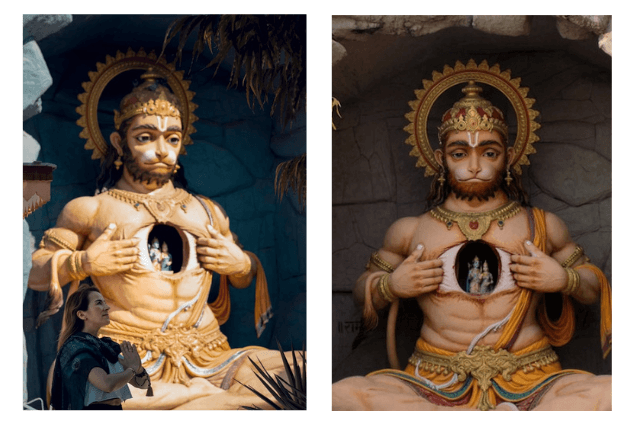
Located at a distance of 6 km, head to the Hanuman Temple, a peaceful temple dedicated to Lord Hanuman known for his strong devotion to Lord Rama.
This sacred site is a peaceful place where you can feel a sense of calm and respect.
Fact: Lord Hanuman once visited Rishikesh in search of the Sanjeevani herb to save Lakshmana’s life during the battle with Ravana.
The temple is usually open from early morning to late evening (6:00 am to 8:00 pm)
It’s best to avoid visiting during peak hours (5:00 pm to 7:00 pm) and enjoy a quieter and more peaceful experience.
7. Lunch at Chotiwala Restaurant, known for its authentic Indian cuisine
After temple hopping, Recharge your energy with a delicious lunch at Chotiwala Restaurant, a popular dining spot renowned for its authentic Indian cuisine.
If you are coming to Rishikesh and you didn’t eat food at the famous Chotiwala then you have missed something.
Located near Ram Jhula, this restaurant has been serving delicious meals since 1958, maintaining the same taste for over 50 years.
When Chotiwala Restaurant first opened in Rishikesh, the owners came up with a unique idea to make it stand out. They placed a man with a long ponytail (choti) and big eyes outside the restaurant. This eye-catching mascot attracted a lot of visitors. That’s why the restaurant became famous as Chotiwala Restaurant.
Chotiwala Restaurant is a unique gem as it has no branches outside Rishikesh and Haridwar, ensuring an exclusive culinary experience.
Note- There is no parking available at the restaurant, so it’s best to either walk or use an e-rickshaw for transportation. Due to its popularity, there might be a waiting period, but the delicious food is well worth it
Operating from 7:30 AM to 11:00 PM, This amazing restaurant offers a wide range of delectable dishes to satisfy your appetite.
8. Explore the vibrant Traditional markets in Rishikesh
Visiting the vibrant traditional markets in Rishikesh is to experience the city’s unique culture and find a variety of souvenirs, handicrafts, clothing, and spiritual items.
Here are some of the must-visit markets:
- Laxman Jhula Market – Located near the iconic Laxman Jhula bridge, this market is a favourite among tourists and locals alike. Here, you’ll find a wide range of products, including clothing, jewellery, spiritual items, and handmade crafts. Don’t miss the opportunity to shop for traditional Indian clothing, such as saris, kurtas, and scarves, as well as intricately designed jewellery.
- Triveni Ghat Market – Situated near the Triveni Ghat, this market is known for its vibrant atmosphere and variety of products. Browse through stalls selling religious items, such as rudraksha beads, idols of Hindu deities, and incense sticks, as well as colourful handicrafts, paintings, and souvenirs. You can also find traditional Indian sweets and snacks to satisfy your cravings.
- Ram Jhula Market – Explore the market near Ram Jhula for a wide selection of goods, including clothing, accessories, jewellery, and handicrafts. This market is known for its unique offerings and is a great place to shop for authentic Indian items.
9. Experience the mesmerizing Ganga Aarti ceremony at Triveni Ghat in the evening.
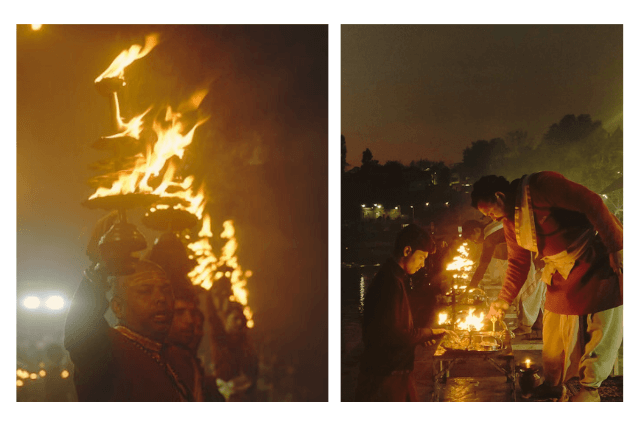
As the day comes to a close, experience the enchanting Ganga Aarti ceremony, a sacred ritual performed at the banks of the Ganga River.
Witness the spectacle of lamps being lit, prayers being offered, and devotional songs being sung as the river glows with the flickering lights.
Join the devotees in offering your prayers and soaking in the spiritual atmosphere.
10. Conclude your day with a delightful dinner at Ganga view cafe
Wrap up your day with a satisfying dinner at Ganga View Cafe, conveniently situated near Laxman Jhula.
This charming eatery offers the perfect setting to unwind and enjoy a delicious meal.
As you dine, take in the serene night view of Rishikesh, with the city lights twinkling against the backdrop of the majestic Ganga River.
It’s the ideal way to conclude your day of exploration and relaxation in this enchanting city.
Rishikesh Itinerary Day 2 : Discover the hidden gems and experience river rafting
On Day 2, we’re gonna head out of Rishikesh to find some hidden treasures.
When we get back, we’ll hit the Ganges for some super fun white-water river rafting.
It’s gonna be a day full of exploring, excitement, and awesome experiences in nature
11. Witness the magnificent morning Arti at Neelkanth Mahadev Temple
Wake up at 4:00 am to catch the incredible aarti at 6:00 am at Neelkanth Mahadev Temple. Located about 32 km away from Rishikesh, it’ll take roughly an hour to get there.
Neelkanth Mahadev Temple is a historical temple situated at the Manikoot Mountain near Rishikesh.
According to ancient stories, Rishikesh is where Lord Shiva drank poison during the churning of the ocean (Samudra Manthan), turning his throat blue. This is why the place is called Neelkanth Mahadev Temple.
What’s special about this temple?
Firstly, it’s surrounded by three mountains: Manikoot, Bharahmakoot, and Vishnukoot.
Secondly, the temple entrance is adorned with colorful sculptures depicting the scene of ocean churning.
After the temple visit, we’ll head to the Neer Garh Waterfall.
12. Neer Garh Waterfall : Nature’s Refreshing Retreat
Neer Garh Waterfall is a breathtaking natural wonder located near Rishikesh. This stunning waterfall stands tall at 25 feet and is formed by the merging of three smaller waterfalls.
It’s a must-see destination for anyone visiting the area.
To reach Neer Garh Waterfall, you’ll travel about 6 kilometers from the Neelkanth Mahadev Temple. The journey by car or taxi takes around 15-20 minutes.
Once you arrive, you might need to trek for about 15 minutes on foot, crossing two bridges along the way where water flows continuously.
The best time to visit Neer Garh Waterfall is after the monsoon, between October and September.
Entry to the waterfall is free, so you can enjoy its beauty without any fees.
Feel free to bring along some food and water for a picnic experience during your trek.
It’s a good idea to pack an extra set of clothes, just in case you feel like taking a refreshing dip in the natural pools formed by the waterfall
. You never know when you’ll want to fully immerse yourself in the beauty of nature at Neer Garh Waterfall.
13. Beatles Ashram: Where History Meets Harmony
Also known as Chaurasi Kuttiya, Beatles Ashram is a renowned tourist attraction in Rishikesh, Uttarakhand.
Situated on the eastern banks of the Ganga River, opposite the Muni ki Reti area, this ashram was once a training center for students of Maharishi Mahesh Yogi.
The ashram gained international fame in 1968 when the legendary English rock band, The Beatles, visited for meditation.
It’s said that their time here was incredibly productive, inspiring some of their most famous songs.
In 1990, Beatles Ashram was handed over to the Forestry Department, and it was later opened to the public in December 2015. Since then, it has become a popular destination for Beatles fans and tourists alike.
The ashram is open from 10 am to 4 pm, and there is no entry fee.
If you plan to meditate here, remember to bring your own mat and a water bottle for your comfort.
Beatles Ashram offers a unique blend of history, music, and tranquility, making it a must-visit spot in Rishikesh.
14. Muni ki Reti Area: Serenity by the Ganges
Muni ki Reti Area, by the Ganges River in Rishikesh, is a peaceful spot away from the city noise. It’s popular for its calm vibe and beautiful surroundings.
You can sit by the river, enjoy the view, and maybe even meditate or do yoga. There are also nice walks along the riverbank, with hills and greenery all around.
15. River Rafting Adventure: Thrills on the Ganges
This thrilling activity promises an adrenaline-packed experience as you navigate through the rapids of the river aboard an inflatable raft.
Safety is a top priority, so you’ll be provided with essential gear like life jackets and helmets, along with expert guidance from your rafting guide.
The best time for rafting is typically in the morning or early afternoon when water levels are optimal.
Make sure to dress comfortably in clothes and shoes that can get wet, and don’t forget to protect your electronics with a waterproof case.
After the exhilarating ride, take a moment to relax on the riverbank, soaking in the stunning scenery and reminiscing about your unforgettable adventure with friends and fellow rafters.
Udaipur Itinerary – Final Thoughts
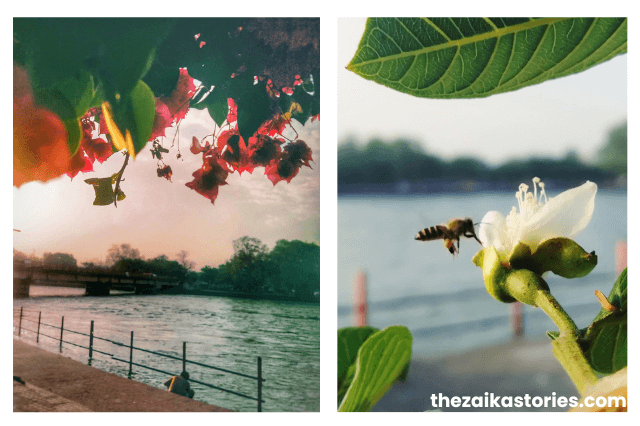
With this we have come to an end of the 2 days Rishikesh Itinerary .
On my Last day, I remember I was Sitting by the river, feeling calm and happy. Thinking back on my time in Rishikesh, I can’t help but smile. The temples were amazing, especially seeing the morning prayers at Neelkanth Mahadev.
And the waterfall was so cool and refreshing! Exploring the Beatles Ashram was fun, and chilling by the riverbank was peaceful. But the best part was definitely rafting on the Ganges!
It was thrilling and beautiful all at once. As I leave Rishikesh, I’m grateful for all the memories I made and the new experiences I had.
Rishikesh will always have a special place in my heart.

